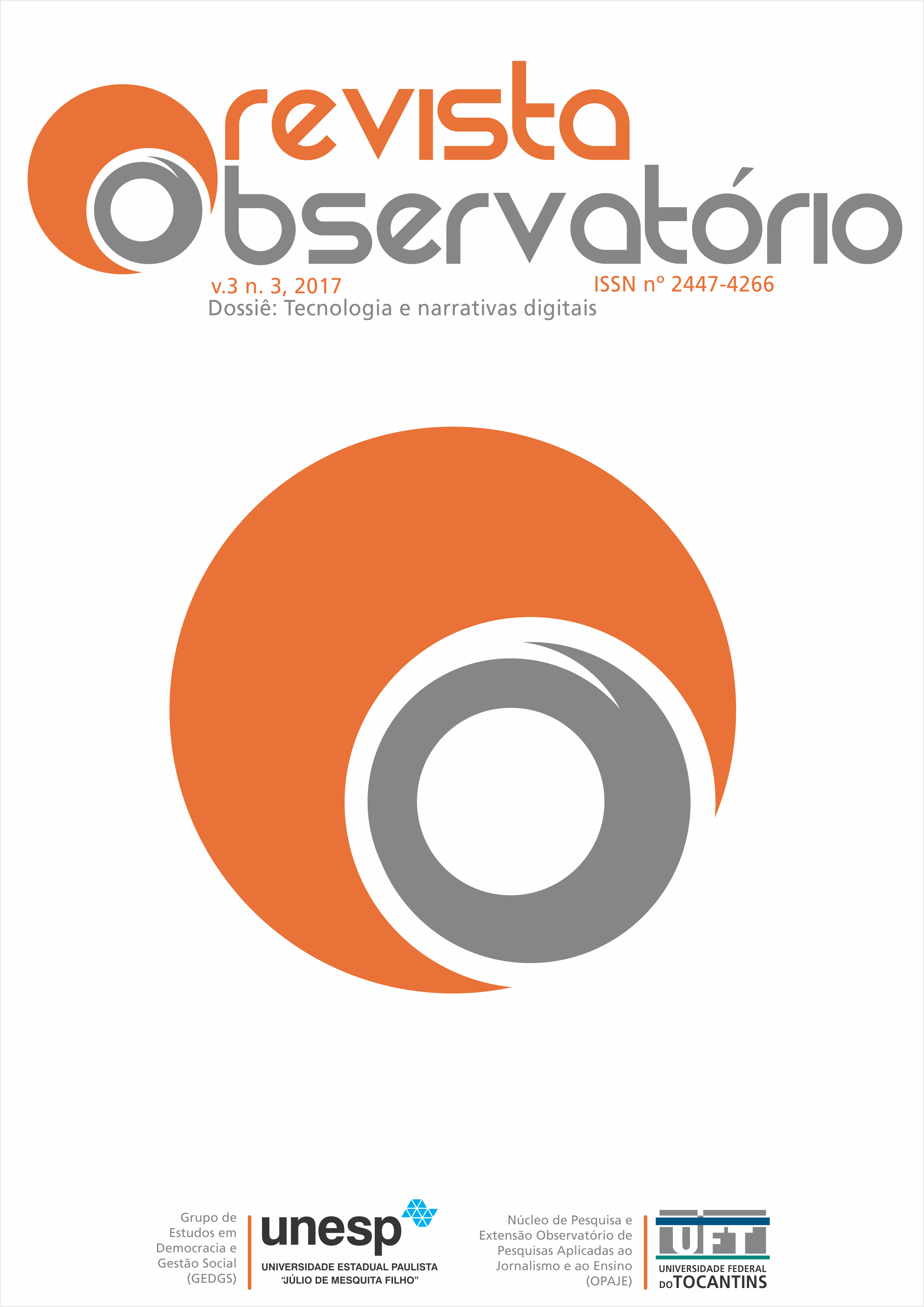THE INTERNET OF THINGS AND INTELLIGENT SYSTEMS IN JOURNALISM: Exploring new narrative ways to reinvent the perception of value of the new generations
DOI:
https://doi.org/10.20873/uft.2447-4266.2017v3n3p85Keywords:
Internet of Things, Digital Narratives, Virtual RealityAbstract
It discusses the network integration capabilities and information flows in the cities environment from intelligent systems in supporting the journalistic production process. Starting from an expanded hierarchy of issuers, including ones nonhuman, connected from the category so-called Internet of Things (IoT), we present the insertion journalism model and its possible use to increase the perception of relevance among consumers content, also allowing the exploration of new narrative forms. The paper also reports the initiative, now underway, to transpose the theoretical model described in a proof of concept applied called Jumper project, an immersive environment for the distribution of news, supported by urban environments with a high density of connections.
Downloads
References
BIGFISHGAMES. 2015 Video Game Statistics & Trends-Who’s Playing What & Why? Disponível em: http://www.bigfishgames.com/blog/2015-global-video-game-stats-whos-playing-what-and-why/ . Acessado em 20/05/2015.
BONACICH, Phillip; LU, Phillip. Introduction to mathematical sociology. New Jersey: Princeton University Press, 2012.
COMSCORE. 2014 Brazil Digital Future in Focus. Disponível em:
DIXON, Colin. What millennials want from TV. In: nScreenMedia, 2014. Disponível em http://www.nscreenmedia.com/wp-content/uploads/nScreenMedia-millennials_final.pdf . Acessado em 18/05/2015.
DUBLON, Gershon; PARADISO, Joseph. Extra Sensory Perception – How a world filed with sensors will change the way we see, hear, think and live. In: Scientific American, p. 23-27, Julho, 2014.
FEENBERG, Andrew. E-book. Transforming technology. A critical theory revisited. New York: Oxford University Press, 2002.
______. E-book. Between reason and experience. Essays in technology and modernity. Cambridge, MA: Mit Press, 2010.
IAB Brasil. Brasil Conectado – Hábitos de consume de mídia – 2014. Disponível em http://pt.slideshare.net/skrol/pesquisa-brasil-conectado . Acessado em 18/05/2015.
IBOPE. Consumo da internet pelos jovens brasileiros cresce 50% em dez anos, aponta IBOPE Media. Publicado em 28/07/2014. Disponível em: http://www.ibope.com.br/pt-br/noticias/Paginas/Consumo-da-internet-pelos-jovens-brasileiros-cresce-50-em-dez-anos-aponta-IBOPE-Media.aspx . Acessado em 18/05/2015.
JENKINS, Henry. E-book. Confronting the challenges of participatory culture: media education for de 21st century. Massachusetts: MIT Press, 2009. Disponível em: <http://www.amazon.com/Confronting-Challenges-Participatory-Culture-Foundation-ebook/dp/B0030DFWZM/ref=sr_1_6?s=digitaltext&ie=UTF8&qid=1391986053&sr=1-6&keywords=henry+jenkins>. Acesso em: 23 abr. 2014
MCLUHAN, M. Os meios de comunicação como extensões do homem. São Paulo: Cultrix, 2007.
MANOVICH, L. The language of new media. Massachusetts: Mit Press, 2001.
MITCHELL, Melanie. Complexity: a guided tour. Nova York: Oxford University Press, 2009.
MORIN, Edgar. Introdução ao pensamento complexo. 4 ed. Porto Alegre: Sulina, 2005.
NEWZOO. Global Games Market Report 2013. Disponível em: http://www.newzoo.com/infographics/global-games-market-report-infographics/ . Acessado em 18/05/2015.
RYAN, B; GROSS, C. The diffusion of hybrid seed corn in two Iowa communities. In: Rural Sociology, v. 8, n. 1, p. 15-24. 1943.
RÜDIGER, Francisco. Introdução às Teorias da Cibercultura: Tecnocracia, Humanismo e Crítica no Pensamento Contemporâneo. 2ª Ed. Porto Alegre: Sulina, 2007.
STATISTA. Average daily media use in the United States from 2010 to 2014 (in minutes). Disponível em http://www.statista.com/statistics/270781/average-daily-media-use-in-the-us/ . Acessado em 18/05/2015.
VAN DIJCK, José. E-book. The culture of connectivity. A critical history of social media. New York: Oxford Press, 2013.
Downloads
Published
How to Cite
Issue
Section
License
[PT] Autores que publicam nesta revista concordam com os seguintes termos:
1. Autores mantém os direitos autorais e concedem à revista, sem pagamento, o direito de primeira publicação, com o trabalho simultaneamente licenciado sob a Creative Commons Attribution License (CC BY-NC 4.0), permitindo o compartilhamento do trabalho com reconhecimento da autoria do trabalho e publicação inicial nesta revista.
Leia todos os termos dos direitos autorais aqui.

